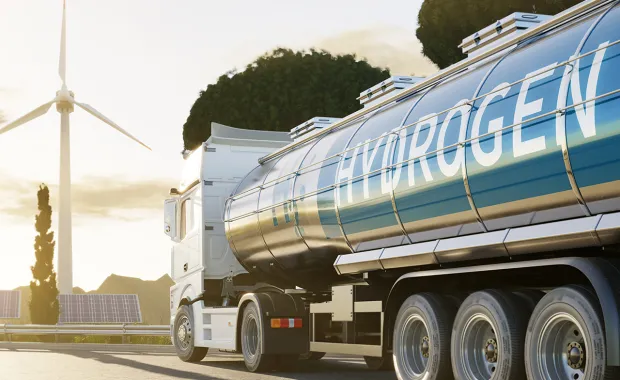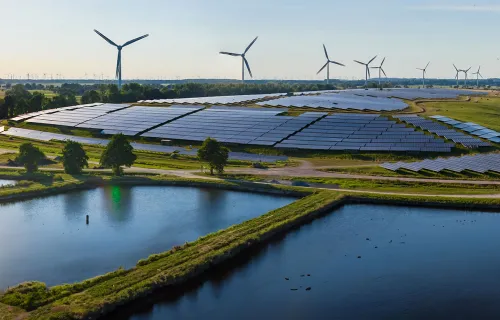The hydrogen revolution is gaining momentum. As the global race to net-zero emissions continues and demand for clean energy sources intensifies, the hydrogen industry is poised to boom and unlock unprecedented opportunities for a healthy planet. Hydrogen’s potential to be a key part of the future of clean energy has captured the attention of governments, industry leaders and environmentalists worldwide. Low-carbon hydrogen is fueling the emerging hydrogen economy and its potential to drive innovation, transform energy generation and make cleaner energy available on an industrial scale.
It is being embraced as a leading form of energy that will contribute to decarbonizing economies. And as a new era of hydrogen-based energy efficiency emerges, Canada is taking its place at the forefront of this pivotal journey.
Innovative activity in Alberta includes the Edmonton Region Hydrogen HUB, an alliance of government, industry, academic and Indigenous leaders. Plans are underway for more than 25 hydrogen-related projects that the HUB says will put the region “on a path to net-zero and help create a future for the energy industry” – while also serving as a blueprint for all of the country’s regions to “join forces to build a strong Canada-wide hydrogen economy.”
Low-carbon hydrogen produced through electrolysis powered by renewable energy sources such as wind or solar – or via fossil fuels using a carbon-capture process – can help to decarbonize a range of sectors that have struggled to reduce emissions harmful to our environment, including steel manufacturing and long-haul transportation. Due to its versatility, hydrogen also has the potential to reduce emissions in the shipping, rail and aviation sectors, as well as in residential power and heating.
Industry currently makes up the bulk of hydrogen demand. It is used in refining, chemical production and the steel sectors, and is most-commonly referred to as gray hydrogen, using fossil fuels such as coal energy, oil and natural gas and therefore responsible for significant annual carbon dioxide (CO2) emissions. This type of hydrogen can have its carbon intensity lowered through the application of Carbon Capture, Utilization and Storage, which involves various methods and technologies to address CO2 emission.
Hydrogen delivers a new dimension of energy efficiency
Hydrogen is an excellent energy carrier that is now serving as a primary means of storing energy for future use. The seasonal and unpredictable nature of solar and wind energy has heightened the focus on energy storage while also bringing market flexibility and energy distribution into sharp focus.
That’s where hydrogen is poised to play a pivotal role. The first wave of the transition to a hydrogen economy will be industry-driven and the next wave will be mobility-related, thanks to hydrogen’s potential as an alternative for heavy industry and long-haul transportation, as well as for aviation, shipping, and rail transportation.
As an alternative to diesel fuel, for example, hydrogen has the potential to decarbonize the heavy-duty trucking sector – which globally is responsible for about one quarter of global road emissions despite representing just 1% of total fleet vehicles.
While hydrogen itself is a clean-burning molecule that can be used in fuel cells to generate emission-free electricity, producing low-carbon hydrogen is a complex process that requires precise control of various parameters to ensure efficiency and safety. Advanced technologies are needed and emerging to improve our understanding and control of these processes.
Canada is among nations leading the hydrogen journey
Europe, through a strategic mix of funding, innovation, and ecosystem collaboration, is making significant strides in exploring hydrogen's potential to meet ambitious net-zero emissions targets.
Hydrogen valleys now operating across Europe are showcasing hydrogen’s distinct and unprecedented advantages. Projects that simulate a modern hydrogen ecosystem – from production and storage to transportation and consumption – are providing crucial opportunities to learn about future technology needs and how the value chain should work.
Meanwhile, the European Hydrogen Backbone (EHB) initiative aims to establish dedicated hydrogen-transportation infrastructure across Europe. More than 30 transport-service operators in Europe are working on how best to transport hydrogen from diverse suppliers to various industries that have the biggest need for hydrogen.
While Europe is leading the way globally, Canada is also moving forward as a worldwide leader in hydrogen production. We are among the top 10 hydrogen producers in the world and home to the world’s largest clean hydrogen facility. Canada possesses all of the components needed – skills, talent, technology and infrastructure – to compete internationally in this emerging space.
The government of Canada’s commitment to creating a clean hydrogen economy includes a target to supply up to 30% of the nation’s energy in the form of hydrogen and to become one of the top three clean hydrogen producers globally by 2050.
Taking advantage of existing infrastructure and skills
Alberta – thanks to its existing infrastructure, technical expertise and investments in the energy market – is among provinces at the forefront of Canada’s hydrogen journey, along with Quebec and the Maritime provinces.
Alberta’s strategy to repurpose existing pipeline infrastructure will position it to distribute higher volumes of hydrogen versus transporting it via trucks or trains. In a first-of-its-kind project for Alberta, natural gas producer ATCO is delivering a blend of natural gas containing hydrogen into a section of the province’s Fort Saskatchewan natural gas distribution system, with hydrogen-blended natural gas being used reliably to fuel homes and businesses. Such hydrogen blending is becoming popular in advanced economies around the world.
In November 2023, Calgary-based engineering firm TES Canada announced plans to invest $4 billion to build a plant in Quebec that will produce low-carbon hydrogen. As the first such hydrogen project in the country and Quebec's biggest decarbonization project to date, the plant is scheduled to open in 2028 in Shawinigan. It is expected to reduce greenhouse gas emissions by 800,000 tonnes a year.
Edmonton’s journey to a hydrogen economy received a boost in 2023 with more than $9.74 million in funding announced through the Federal Government’s Prairies Economic Development Canada department. The financial support will help strengthen the region’s hydrogen supply chain, increase access to refuelling equipment and upgrade testing facilities for hydrogen fuel infrastructure. The initiative includes about $3.74 million to help attract foreign investors to the region and to further develop the local labour market.
The Federal Government is also investing $300 million through the Strategic Innovation Fund's Net Zero Accelerator initiative – alongside Alberta’s contribution of $161.5 million – to support a $1.6 billion project by Air Products Canada Ltd. to advance clean fuels and clean energy in Canada. These contributions, along with others, will support construction in Edmonton of a hydrogen production and liquefaction facility that uses autothermal reforming and carbon capture technology.
Edmonton International Airport, meanwhile, is one of the first airports in Canada to actively pursue and invest in the transition to hydrogen as an alternative fuel source – not only for aircraft but all related transportation, including trucks and carriers that are part of the air-transport ecosystem. Edmonton’s airport, with its airside vehicles and taxis that operate predominantly within the airport vicinity, is uniquely positioned to both drive demand and accelerate hydrogen supply.
The Edmonton region’s status as Canada's first ‘hydrogen hub’ positions it to be a nexus of demand and supply. The region’s strategic location, abundant resources, innovative spirit, and collaborative approach across sectors positions it as a driving force for innovation. Meanwhile, future opportunities to develop hydrogen production in Alberta’s Indigenous communities are also being explored.
CGI is making a difference globally
As the hydrogen trend gains momentum, CGI is playing an important leadership role. CGI is committed to accelerating hydrogen adoption based on our deep and proven energy-sector expertise that includes energy-market liberalization, renewables management and data management.
Our specialists are working with major energy and utilities organizations to advance the unique role they can play in accelerating the decarbonization of our planet, including initiatives to:
- Develop a global hydrogen market to advance supplier diversity and energy security.
- Enable hydrogen trading and carbon targets set by regulators and governments;
- Consider the production of hydrogen close to demand sites;
- Combine hydrogen production and storage with wind and solar power plants;
Our success with organizations charting a new path to hydrogen production and use includes a client initiative for the end-to-end control of one of Europe’s largest low-carbon hydrogen plants. The energy company chose CGI to implement a pivotal new solution that accurately monitors its entire hydrogen-production process. Operators now have the tools, indicators and alarms needed to manage the complete manufacturing journey, integrating systems that control the photovoltaic plant’s energy production with the production and supply of hydrogen to the facility.
A major European gas-transmission operator turned to CGI as it set out to integrate hydrogen into its current value chain. Establishing a commercial data-exchange platform was too complex to manage by spreadsheet and too costly to integrate directly into the company’s legacy IT landscape. With our intelligent data exchange platform CGI AgileDX-Hydrogen, we jointly developed a proof of concept and the power to scale in just five weeks.
CGI experts are also currently working with future-focused steel makers in Europe as they pursue new hydrogen initiatives and capabilities that aim to optimize clean steel production. Leading global auto manufacturers developing significant new hydrogen strategies are also collaborating with CGI to unlock new opportunities. Bringing the promise of a hydrogen economy to life will require strategic collaboration that brings together industry, supply-chain partners, governments and regulators.
Finally, CGI is uniquely positioned with our cross-industry focus to help drive innovation. Our specialists are working with clients in manufacturing, oil & gas, utilities and with new startups. They hold a position of trust through their delivery of actionable insights and value. This enables CGI to explore and pursue new forms of collaboration, which results in promising solutions being put into production that are both profitable and help to achieve a more-sustainable planet.





